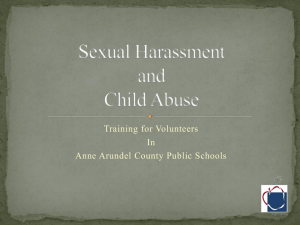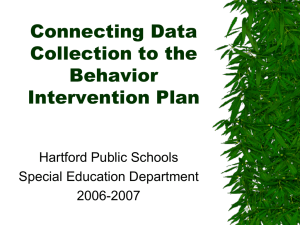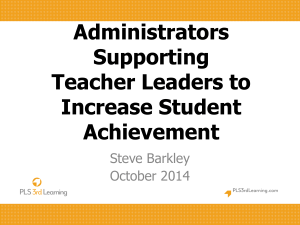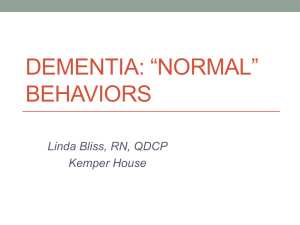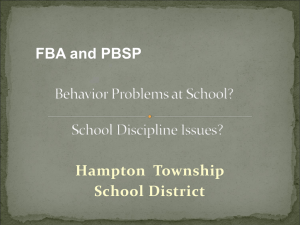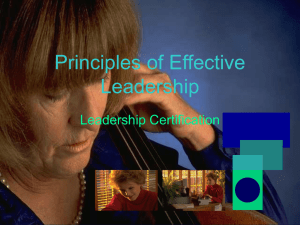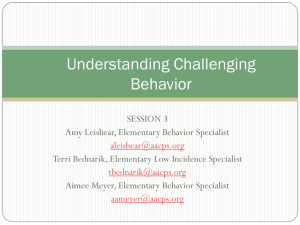Elswick, Susan - Functional Behavior Assessments
advertisement
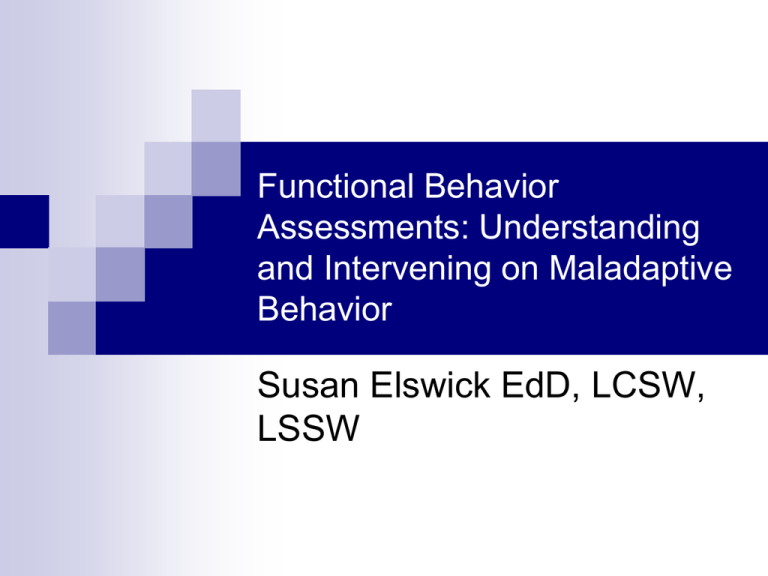
Functional Behavior Assessments: Understanding and Intervening on Maladaptive Behavior Susan Elswick EdD, LCSW, LSSW What is Behavior? Behavior is the activity of a living organism; human behavior includes everything that people do It is an organisms interaction with its environment Cooper Heron, and Heward (2007) Why do students display inappropriate behaviors? Behavior is the way children communicate Many children do not have social-emotional literacy Attempt to get needs met through behaviors and actions It has worked for them in the past (history of reinforcement) It is a behavior that has been reinforced To fulfill a need What Maintains Behavior? Behaviors are maintained by what the student gets out of displaying the behavior and this is often described as the function of behavior Function=pay off or reward for the student Why should we intervene? Research notes “that many students that misbehave often times also present with serious learning challenges.” (Walker, Stieber, Ramsey, & O’Neill, 1993) “Research strongly suggests that if schools raise their level of achievement, behavior decreases; and if schools work to decrease behavior problems, academics improve.” (Hawkins, Catalano, Kosterman, Abbott, & Hill, 1999) Why Should We intervene? It has been noted that “school districts that utilize office referrals, out-of-school suspensions, and expulsions-without a comprehensive system that teaches positive and expected behaviors and rewards the same- are shown to actually have higher rates of problem behavior and academic failure.” (Mayer, Butterworth, Nafpaktitis, & Suzer-Azaroff, 1983) Why is it important to determine functions of behavior? Keeps us from continuing ineffective interventions Helps to determine appropriate interventions Saves time and resources Assists in increasing the likelihood that the students outcomes will be successful The Law: When are FBAs required by IDEA ‘97 An FBA must be conducted if suspensions or placements in an alternative setting equal more than 10 school days in a school year suspensions or placements constitute a change in placement (length, duration, proximity) the student is placed in an Interim Alternative Education Setting (IAES) for 45 days for weapons or drug offenses a due process hearing officer places a student in an IAES for behavior that is dangerous to self or others (Drasgow & Yell, 2001) The Law: When Should FBAs be Conducted? An FBA should be conducted when the student’s problem behavior impedes the learning of self or others when there is a known history of problem behavior when the student’s suspensions or placements approach 10 cumulative days when the student’s behavior presents a danger to self or others (Drasgow & Yell, 2001; Martin, 1999) Timelines for FBAs FBAs must be conducted within 10 business days when the student *is first removed for more than 10 school days *removed in a manner that constitutes a change in placement *placed in an IAES for dangerous behavior * BIPs based on the FBA must be implemented as quickly as possible Three Major Points Supporting the Disciplinary Changes of IDEA’97 Emphasis on the use of positive behavioral interventions, supports, and services for students who exhibit behavior problems Use of positive programming to teach appropriate behaviors rather than simply using punishment-based procedures to eliminate inappropriate behavior Updates to FBA BIP Law New Special Education Restraint Law and the BIP process Parental permission is required prior to conducting an FBA Violations of the Law: National Due Process Hearings School districts lost in 13 out of 14 (94%) state level due process hearings. School districts failed to conduct an FBA and develop a BIP when it was required by IDEA in 11 of the cases. School districts lost in 3 of the cases for development of an inadequate FBA. Three Tiered Service Model Academic Systems Intensive, Individual Interventions •Individual Students •High Intensity Targeted Interventions •At-risk students •Classroom/small group remediation Universal Instruction •All settings, all students •Preventive, proactive Behavioral Systems 1-5% 1-5% 5-10% Intensive, Individual Interventions •Individual Students •High Interventions 5-10% PBIS 80-90% 80-90% PBIS Targeted Interventions •At-risk students •Classroom/small group focus Universal Prevention •All settings, all students •Preventive, proactive Who can conduct an FBA and write a BIP? Functional Behavior Assessment It uses an ABC approach (antecedent, behavior, and consequence)= 3 term contingency The first step in addressing problem behaviors Gathers data about the student and their behavior (indirect and direct assessments) Includes an interview of the teacher, family, and the student Identifies students strengths and needs; reinforcers and preferences Helps to reveal patterns in behaviors Antecedent Antecedent- The set of environmental conditions that immediately occur before a behavior Directives/ direct request, redirection, ask to complete/ participate in a non-preferred activity, etc. Behavior Behavior- A movement that produces a change in the environment Consequence Consequence- The set of environmental conditions that immediately occur after a behavior Sent to the office, placed in time out, teacher supplied a verbal reprimand, teacher provides attention, student is given a wanted toy, etc. 4 Functions of Behavior There are Four Functions: Attention- from peers and adults Escape/ Avoidance- from persons, activities, or environment Sensory- tactile needs or inputs Access to a Tangible- an actual item (pencil, computer, food, etc) How to Determine Function? Functional Behavior Assessment (FBA) A systematic method of assessing information about the purpose of a problem behavior; results are used to guide interventions Cooper, Heron, and Heward (2007) Phases of FBA Phase I: Descriptive Phase Phase II: Interpretive Phase Phase III: Verification Phase Phase IV: Treatment Implementation & Monitoring Phase I: Descriptive Phase Indirect Methods • • • • • Interviews - Teacher, Parent, Student Rating Scales Academic Record Review Discipline Record Review Previous Intervention Attempts Phase I: Descriptive Phase Direct Methods - Direct Observations • • • • • Scatter Plot ABC Assessment Frequency or Event Recording Interval Recording Rating Forms Phase II: Interpretive Phase Involves the development of hypothesis or summary statements about the triggers (antecedents) setting off the behavior and events (consequences) maintaining behavior. Phase III: Verification Phase Direct changes are made in the environment to test the hypothesis or summary statements. • Functional or Experimental Analysis Hypothesis-based Multi-element (multiple behaviors) Brief • Intervention Testing Phase IV: Intervention Development & Monitoring Focus on increasing positive behaviors Focus on teaching skills Focus on making problem behaviors inefficient, ineffective, and irrelevant Focus on proactive instead of reactive strategies Monitored closely for integrity • Direct Observation • Intervention Checklists Indirect Assessment Indirect Methods • Interviews - Teacher, Parent, Student • Rating Scales • Academic Record Review • Discipline Record Review • Previous Intervention Attempts/ Review Questions 1. 2. 3. 4. 5. 6. What is the setting event? (happens before they get to us) What appears to set off the problem behavior (antecedent/the predictor/ trigger)? What do the problem behaviors look like? What happens right after behavior occurs? (consequence) What does she gain from the behavior (function)? What do you want her to do instead? (replacement behavior) It’s as easy as the A-B-C’s!!! Examples of Indirect Assessments Motivational Assessment Scale (MAS) Created by Durrand and Crimmins 1986 Likered scale assessment used to determine function of the behavior Assists with determining function of behavior Indirect Observation Measure Other examples: FAST, QABF, FAI, etc. Direct Assessment Direct Methods Direct Observations • Scatter Plot • ABC Assessment • Frequency or Event Recording • Interval Recording • Rating Forms Additional Considerations Many problem behaviors may serve one function One problem behavior may serve multiple functions in the same setting Same problem behavior may serve a different function in a different context Function of a particular behavior may change over time He does not care about anything!?! Choosing a Reinforcer Preference Assessments are important Index Card Forced Choice Preference Assessment Hierarchy of Reinforcers Free play observation Interviews Understanding satiation/ deprivation Functional Analysis Direct changes are made in the environment to test the hypothesis or summary statements. • Functional or Experimental Analysis • Hypothesis-based Multi-element (multiple behaviors) Brief Intervention Testing How to Conduct an FA in the classroom? Use in Context of the Classroom Do 5 minute sessions in each condition Alone Attention Play Demand Functional Analysis Protocol Condition Attention EO Consequence Contingency Ignored Th. Attends to PB Pos reinf (dep) (attention) ________________________________________________________ Demand Present Time out for PB Neg Reinf Demand (escape) Alone No stimulation N/A N/A (automatic) Play No work, open, N/A Control free time, attention Ways to Change Behavior Change the Antecedent The set of environmental conditions that immediately occur before a behavior Change the Behavior A movement that produces a change in the environment Changing the “A” actual cuts problem behavior before it gets out of hand (PBIS Techniques) This is actually occurs by teaching Replacement Behaviors Change the Consequence The set of environmental conditions that immediately occur after a behavior This takes great patience, strength, and consistency Replacement Behaviors Replacement behaviors are behaviors you want to replace the target/ maladaptive behaviors displayed. You Must Teach Replacement Behaviors!!! Identifying Teachable Moments Data Collection Understanding data collection is imperative to accurate data collection, seeing a true picture of target behavior, and ensuring fidelity of the intervention/ assessment Types of data collection/ recording: Partial interval Whole interval Latency Frequency/ rate Duration Partial Interval Type of Interval Recording Used for behaviors that appear continuous Provides an estimate of actual number of times the behavior occurs target behavior counted if it happened anytime during the interval (over estimate) 15s X 30s 45s 1min 1m 15 1min 30 Whole Interval Type of Interval Recording Used for behaviors that appear continuous Provides an estimate of actual number of times the behavior occurs Occurrence of target behavior counted ONLY if it lasts the entire predetermined interval (underestimate of behavior) 15s 30s X 45s 1min 1m 15 1min 30 Duration Used to look at the length of time the student engages in the behavior Latency Similar to duration but more interested in when behavior stops and starts How long it takes a student to respond to a teacher request … “Clear your desk and get out a piece of paper and a pencil.” Frequency/ rate Event Recording Total count of number of times the behavior occurs Tally marks used to determine frequency Other ways to Collect Data about Behavior A-B-C (Continuous or Narrative Forms) Clickers Timers (Red-All-Gone) The Penny Pass Sample Behavior Trackers H.U.G. (Hello, Update, Goodbye) Name: ____________________________ Date: ________________ Please indicate whether the student has met the goal during the time period indicated: Meets = 2 pts So, so = 1 point Doesn’t meet = 0 pts HUG Daily Goal _____/_____ HUG Daily Score _____/_____ Teacher Comments: Please state briefly any specific behaviors or achievements that demonstrate the student’s progress. AM to Recess Goals AM Recess to AM Recess Lunch Lunch Recess PM Be Safe J K L J K L J K L J K L J K L Be Kind J K L J K L J K L J K L J K L Be Responsible J K L J K L J K L J K L J K L Total Points Teacher Initials Parent’s Signature ___________________________________ Parent’s Comments _________________________________________________________ __________________________________________________________________________ Collect data pre, during, and post intervention Determine the target behavior Define it in clear operational terms Determine when to collect data What data collection method/recording type Data collection (observation, reports, data logs, measurement tool/ assessment, etc) Collect baseline data collected prior to intervention Summarize and graph data Put an intervention in Place/ monitor- still collecting data Review data and make changes as needed Graph the data: Visual Analysis of Data This type of clinical evaluation assists the clinician/teacher with making data driven decisions in practice. Can see instantly if the intervention is working Great proof of intervention success Baseline data is needed… What is a BIP? Behavior Intervention Plan includes: Focus Focus Focus on increasing positive behaviors on teaching skills on making problem behaviors inefficient, ineffective, and irrelevant Focus on proactive instead of reactive strategies Monitored closely for integrity • • Direct Observation Intervention Checklists (this is needed for BIP implementation) Behavior Intervention Plans should include: Replacement behavior Well defined target behavior Goal for target behavior Positive Behavior Interventions Supports Interventions Interventions should be based on the functions maintaining the behavior Utilize data gathered in the indirect and direct assessment process to drive your interventions Putting an inappropriate intervention in place can be counterproductive and actually reinforce the target behavior How to Write an Effective BIP Use a Strengths based approach Write specific, observable, obtainable, and measurable goals Use the function of the behavior (your FBA results) as your driving tool for writing a BIP Allow the student some autonomy Use PBS techniques (Positive Behavior Strategies) How to IMPLEMENT an Effective BIP Monitor and evaluate BIP (for 3-4 weeks) Update BIP if progress is not noted Teach Replacement Behaviors (WE MUST TEACH!) Things to Remember before intervention… Planned Ignoring Break eye contact, move away, and use a stony face/ silence Praise Immediate Frequent Enthusiastic Eye contact Describe behavior (behavior specific praise) Variety Jenson, 2003 Words of Caution While the following slides are grouped by function, many interventions work with multiple functions and/or regardless of the function (response cost or punishmentbased interventions)! Interventions for Attention-Maintained Behaviors Attention Maintained Behavior Interventions The Attention Tag/ Ribbon Non-exclusionary timeout procedure Need a ribbon or a tag that is visible and noticeable Student is supplied the ribbon/ tag upon arrival to school If student displays unwanted behavior Then the ribbon is removed and student is ignored for 3 minutes or until misbehavior stops JABA Attention The Good Behavior Game Interdependent Group contingent reinforcement procedure Created in 1969 by Barrish, Saunders, and Wolf for a 4th grade classroom How? Explain GBG Game Create group rules/ posters (students assist) Define and explain behaviors that are wanted in class and explain behaviors that will create a loss in points Practice appropriate behavior/ expectations (role play, rehearsal, etc) Designate a time to use the GBG Allow students to choose a group reward (preference assessment) Create groups/ teams Track daily with tally marks visible on wall/ board (public posting) Attention Caught ‘ya Being Good Uses Positive Behavior Intervention and Supports/ Antecedent Control The premise is to catch the students “Being Good” and Praise him. This focuses on praise for positive behaviors which encourages good behavior. Caught ‘ya Being Good Taking Pictures Make it a Mystery Have a Bulletin Board Make an “Ultimate” Incentive Afternoon Announcements/ Letters Stickers/ Stars/ Necklaces/ Silly Bands Identified students get to have lunch with the principal PBIS/ JABA Attention Proximity Control/ Proximity Praise Teacher stays within close proximity of the student who is displaying inappropriate behavior. Instructor ignores misbehavior of the student and praises students near by that are displaying appropriate behavior Then when student modifies his behavior IMMEDIATE praise must be implemented Attention Differential Reinforcement – It is the reinforcement of one form of the behavior and not another Uses positive reinforcement to differentiate appropriate student behavior from inappropriate behavior Types of Differential Reinforcement DRO- (Other) ignore problem behavior while reinforcing any replacement behavior within a specified time frame DRA- (Alternative) ignore inappropriate behavior and reinforce an alternative behavior DRH- (High Rates) reinforce only after the appropriate behavior has happened a set/ determined number of times DRL- (Low Rates) reinforce individual only if the behavior occurs at a predetermined low rate DRC-(Communicative) ignore inappropriate behavior and reinforce a replacement skill/ communication skill that leads to a need DRI- (Incompatible) Instructor reinforces a behavior that actually interferes with the inappropriate behavior and ignores the inappropriate behavior Attention Extinction Extinction is the non-reinforcement of previously reinforced behaviors This procedure includes ignoring a behavior-withholding attention for a previously reinforced response When inappropriate behavior is ignored another appropriate behavior must be reinforced (Fair Pair Rule) Beware of the difficulty of using extinction in a classroom!!!! What is an extinction burst??? Attention Token Economy A Token Economy is a reinforcement system that uses symbols to change behavior. Tokens are earned for good behaviors, and later exchanged for a preferred item/ activity/ reinforcer Check-in Check-out Cycle Morning Check-In BIP Weekly Data Review Class Check-Out Teacher Teacher Checks Checks Home Check-In 4-5 Weeks Graph Reviewed Program Update Class Check-In Afternoon Check-Out Exit Attention Check-in Check-out (CICO) GOALS 1. Follow the teacher’s directions the first time. 2. Complete all assignments in a timely manner. 3. Complete all homework assignments. Teacher Initials Parents Comments Language Arts Math 0 0 1 0 0 1 2 0 1 2 0 1 2 Reading Social Studies/ Science 2 0 1 2 0 1 2 1 2 0 1 2 0 1 2 1 2 0 1 2 0 1 2 Total Points Take a 10-15 Minute Break Interventions for Escape-Maintained Behaviors Escape Maintained Behavior Interventions Overcorrection Restitutional- requires student to correct the effects of the misbehavior by restoring the environment to better than its original condition Positive- requires student to practice appropriate behavior an abundant number of times Neutral Practice- student repeats an action that is neither related to terminal behavior nor is it restitutional/ also known as contingent exercise Full Cleanliness- used in potty training Escape Maintained Verbal Prompt- Use questions to prompt behavior Gestural prompt- teacher uses gestures to encourage behavior Physical/ tactile prompt- touch students shoulder, hand, finger, etc Manual Guidance- known as hand over hand Use a least to most prompting system “Wait, Ask, say, show, do” wait for child to initiate after a directive is provided, ask the student a general question, “what do you need to do?,” say what is expected, show a gesture, and then prompt to complete the action. Escape Non-contingent Break/ Chunking the work Allowing the student a break on a fixed schedule/ interval Break the activity into smaller parts that are followed by a reinforcer/ break You can also do a contingent break procedure Escape Break Card This is a procedure that is based on Skinner’s Verbal Behavior- manding procedures Student must be taught to request a break in an appropriate manner Need a visual cue (let student choose) Set a limit on the break card Make sure all teachers are allowing This contingency Escape Therapy Box (Differential Reinforcement of Communicative Behavior) Procedure teaches student to mand for a break Uses a break card contingency Teaches the student and teacher about behavior chains Emotional Literacy training Escape Behavioral Momentum Helps to increase compliance Usually seen in activities that are viewed as difficult for the student This procedure includes identifying a minimum of three behaviors which are considered high probability behaviors (student can and will complete). At least three request using the high p are done in succession immediately before making a request to complete a low p activity. Once compliance is started it will usually continue…remember that praise is needed after each high p activity is completed Escape Daily Schedule (Visual) Use a small visual schedule on the students desk Pocket schedule The student can actively participate in checking off completed work Visibly see what is coming next Use this in conjunction with a break card (set up on schedule when breaks will happen) Visual Schedule Escape Layered Grouping A strategy used to provide appropriate instruction for each person in the group. This is a type of differentiated instruction. Start off with a basic group skill, after the initial group period, dismiss students whom upcoming events will not be appropriate (you can use a timer), they work in a smaller group on needed skills, then after the second activity is completed a few more students are dismissed, the last group is held with the most accelerated students that is focused on more challenging materials and then lengthen group time for each group. This is a great way to utilize independent study areas, rotations, etc… Escape Runners We must make the classroom a better set of conditions Where is the kid going? Safety first Stimulus Pairing with a Visual Symbol Teaching a manding procedure for a break Interventions for Beh Maintained by Access to Tangible Access to Tangible “First - Then” Contingency or “If-Then” First-Then Boards are used to assist the student with understanding and completing task before participating in a preferred activity Offering Choices… Sample First/Then Boards Tangible Busy Box Follows the First-Then Contingency Conduct a Preference Assessment (tangible likes) Place tangible rewards in a shoe box Student has access to the box after a terminal behavior is observed Can be helpful for students who finish work quickly too Interventions for Sensory-Maintained Behaviors Sensory Provide sensory outputs Wiggle Games/ movement activities Taking a Shower Getting Ready for Bed Get Ready Spaghetti/ Melt Like an Ice cream Cone Use Movement activities during transitions too (tip toe to the table, walk like a quiet monkey, etc) Throwing the Wiggles Sensory Box Scheduling OT/PT after hard work activities Sensory Self-monitoring Very effective for student with ADHD, Asperger’s, and Impulse control issues Student is made aware of the maladaptive behavior they display The student is informed of the behaviors that are expected Coping skills are taught to assist with sensory needs Student ranks himself on displaying appropriate behavior Timer used/ motovator (watch/ beeper)/ sound. The system is set to go off on a fixed schedule. When the timer goes off the student grades themselves on behavior at the time the timer went off, every 5th time the timer goes off the teacher is prompted by the student to grade the student Assists student with self-regulation Sensory Differential Reinforcement of Incompatible Behaviors (DRI) This is used to stop maladaptive behaviors from happening due to the inability for the student to participate in the unwanted behavior while completing other tasks (thumb sucking, hand flapping, nail biting, etc) Sensory Maintained Behavior Provide Opportunities for Kinesthetic Learning Kinesthetic Learning, also known as Quantum Learning, uses touch and movements to help students learn Think of learning to drive a stick shift; your brain remembers through your body’s coordinated movements Sensory-Kinesthetic Active involvement in dramatic skits, field trips, hands-on projects, and physical activity helps students remember and retain knowledge they may loose if the material was only seen or heard… Think Show! Practice Social Skills (taking Turns) by partnering in a dance, play or exercise Rehearse math or counting facts while marching or skipping Learn vocabulary definitions while encountering flashcards alongside an obstacle course Learning Left and Right through dance moves Science Experiments Teach concepts such as open and close with a door/ box, over and under with an obstacle course Sensory Weighted vest Undershirts Theraband around legs of chairs Fidgets Velcro under desk Contingent Break for sensory break Resources http://www.usu.edu/teachall/text/behavior/LRBI.htm www.pbis.org www.interventioncentral.com www.disciplinehelp.com http://csefel.vanderbilt.edu/ http://iris.peabody.vanderbilt.edu/rti01_overview/chalcycl e.htm www.learningearnings.com www.educatorshandbook.com http://seab.envmed.rochester.edu/jaba/ Resources 2002 Surgeon General’s Report on Antisocial Behavior (http://www.surgeongeneral.gov/library/youthviolence/) Center on Social and Emotional Foundations for Early Learning (http://www.csefel/uiuc.edu/what-works.html) Florida PBS Project (http://flpbs.fmhi.usf.edu/index.asp) Center for the Study and Prevention of Violence (http://www.colorado.edu/cspv/) Safe and Responsive Schools Project (http://www.indiana.edu/~safescchl/index.html) Collaborative for Academic, Social and Emotional Learning (http://www.casel.org/home/index.php) Behavior Services of the Mid-South LLC Dr. Susan Elswick CEO/ President (901)484-3546 behaviormidsouth@gmail.com
